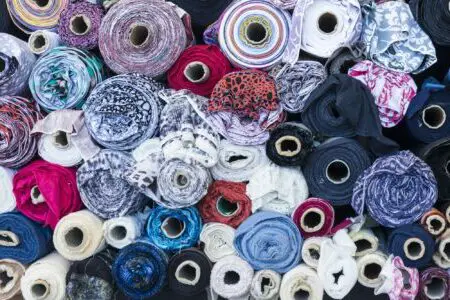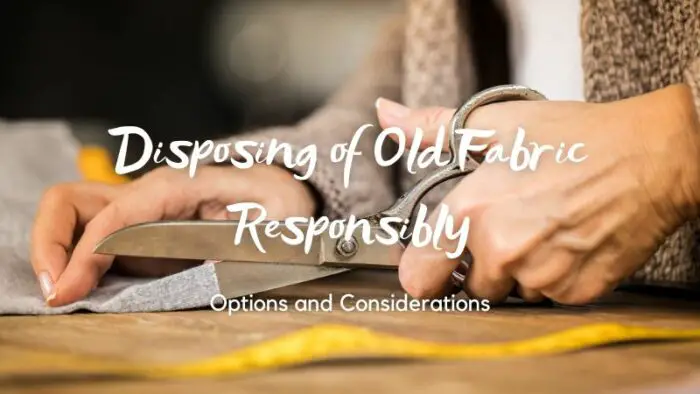Usually, the fabric should not be placed in the recycle bin. Most recycling facilities are not equipped to handle textiles, and fabrics can cause problems in the recycling process. They can get tangled in the machinery, contaminating the recycled materials and making it more challenging to recycle other items.
There are some exceptions to this rule. Some communities may have special programs for recycling textiles, such as clothing and bedding. You can check with your local recycling facility or municipality to see if there are specific guidelines for recycling materials in your area.
If you have old clothing or other textiles that you no longer want or need, there are other options for disposing of them responsibly. One option is to donate them to a thrift store or charitable organization. Another option is to recycle them through a program specifically designed for textiles, such as TerraCycle’s National Clothing Recycling Program. These programs take old clothing and other fabrics and either reuse them or recycle them into new products, such as insulation or automotive materials.
What To Do With Used Fabric
There are several options for disposing of old fabric in a responsible and environmentally friendly way:
- Donate it: Many thrift stores and charitable organizations accept gently used clothing and other textiles donations. Donating your old fabric can give it a new life and help those in need.
- Recycle it: Some communities may have programs for recycling textiles, such as clothing and bedding. You can check with your local recycling facility or municipality to see if there are specific guidelines for recycling materials in your area.
- Upcycle it: Instead of throwing away old fabric, you can try repurposing it into something new. This could include making it into a quilt, pillow, or other home decor item. Many tutorials and resources are available online to help you start upcycling.
- Compost it: Natural fibers such as cotton and wool can be composted, although they may take longer to break down compared to food waste. If you have a home compost bin or access to a municipal composting facility, you can add your old fabric to the compost pile. Just be sure to cut it into small pieces first.
- Dispose of it correctly: If you cannot recycle, donate, upcycle, or compost your old fabric, you should dispose of it properly. This means placing it in the trash and ensuring it goes to a landfill. While this is not the most environmentally friendly option, it is essential to ensure that textiles do not end up in the environment, where they can cause problems such as litter and wildlife entanglement.

Upcycling Used Fabric
There are many ways to reuse used fabric, and it can be a fun and creative way to reduce waste and give the old fabric a new life. Here are a few ideas for reusing used material:
- Sewing projects: If you enjoy sewing, you can use old fabric to make various items such as bags, pillows, curtains, and more. There are many tutorials and patterns available online to help you get started.
- Home decor: Used fabric can be used to create a variety of home decor items, such as throw pillows, cushions, rugs, and more. You can use fabric scraps to make a patchwork quilt or upholster an old piece of furniture.
- Clothing and accessories: Depending on the condition of the fabric, you may be able to cut it into pieces and use it to make clothing or accessories such as scarves, headbands, or bags.
- Crafts: Used fabric can be used for various crafts, such as making dolls, stuffed animals, or fabric flowers. You can also use it to make fabric-covered journals, picture frames, or other decorative items.
- Cleaning and polishing: Old fabric can be cut into small pieces and used as rags for cleaning or polishing.
Reusing used fabric can reduce waste and give old items a new purpose. It is a creative and environmentally friendly way to extend the life of materials that might otherwise be discarded.
Composting Used Fabric
Composting used fabric can be an excellent way to dispose of natural fiber textiles such as cotton, wool, and linen in an environmentally friendly manner. Here are the steps for composting used fabric:
- Cut the fabric into small pieces: Cut it into small pieces or shred it using scissors or a shredding tool. This will help it break down more quickly in the compost pile.
- Add the fabric to your compost bin: Place the small pieces of fabric in your compost bin or pile, along with other compostable materials such as food scraps and yard waste.
- Mix and turn the compost: Regularly mix and turn the compost to ensure that it breaks down properly and provides oxygen to the microorganisms breaking down the organic matter.
- Monitor the moisture and temperature: Keep the compost moist and at the proper temperature to encourage the decomposition process.
- Wait for the compost to mature: It may take longer for the fabric to break down in the compost pile than other organic materials. Be patient and allow the compost to develop before using it in your garden.
It is important to note that not all textiles can be composted. Synthetic materials such as polyester and nylon should not be composted, as they do not break down like natural fibers. These materials should be disposed of in the trash.
Where to Donate Fabric
There are several options for donating fabric, including:
- Thrift stores: Many thrift stores accept donations of gently used clothing and other textiles. You can check with your local thrift store to see if they accept fabric donations and to find out about their specific guidelines.
- Charitable organizations: Many charitable organizations, such as Goodwill and the Salvation Army, accept gently used clothing and other textiles donations. You can check with your local charitable organization to see if they accept fabric donations and to find out about their specific guidelines.
- Fabric banks: Some organizations, such as Fabric Recycling UK, operate fabric banks that accept donations of fabric, which is then used to create new products or donate to charitable organizations. You can search online to see any fabric banks in your area.
- Crafting groups: You may be able to donate fabric to a local crafting group or community center. These groups often use donated fabric for projects such as quilting or sewing.
Donating fabric can give it a new life and help those in need. It is a responsible and environmentally friendly way to dispose of old textiles. Just be sure to check with the organization you donate to find out about their specific guidelines and ensure that your fabric is in good condition.
Conclusion
The fabric should not generally be placed in the recycle bin, as most recycling facilities are not equipped to handle textiles. However, there are several options for disposing of old fabric in a responsible and environmentally friendly way, including donating it to a thrift store or charitable organization, recycling it through a program specifically designed for textiles, upcycling it into something new, composting natural fibers, or disposing of it properly in the trash.
By choosing one of these options, you can help reduce waste and give the old fabric a new purpose.

